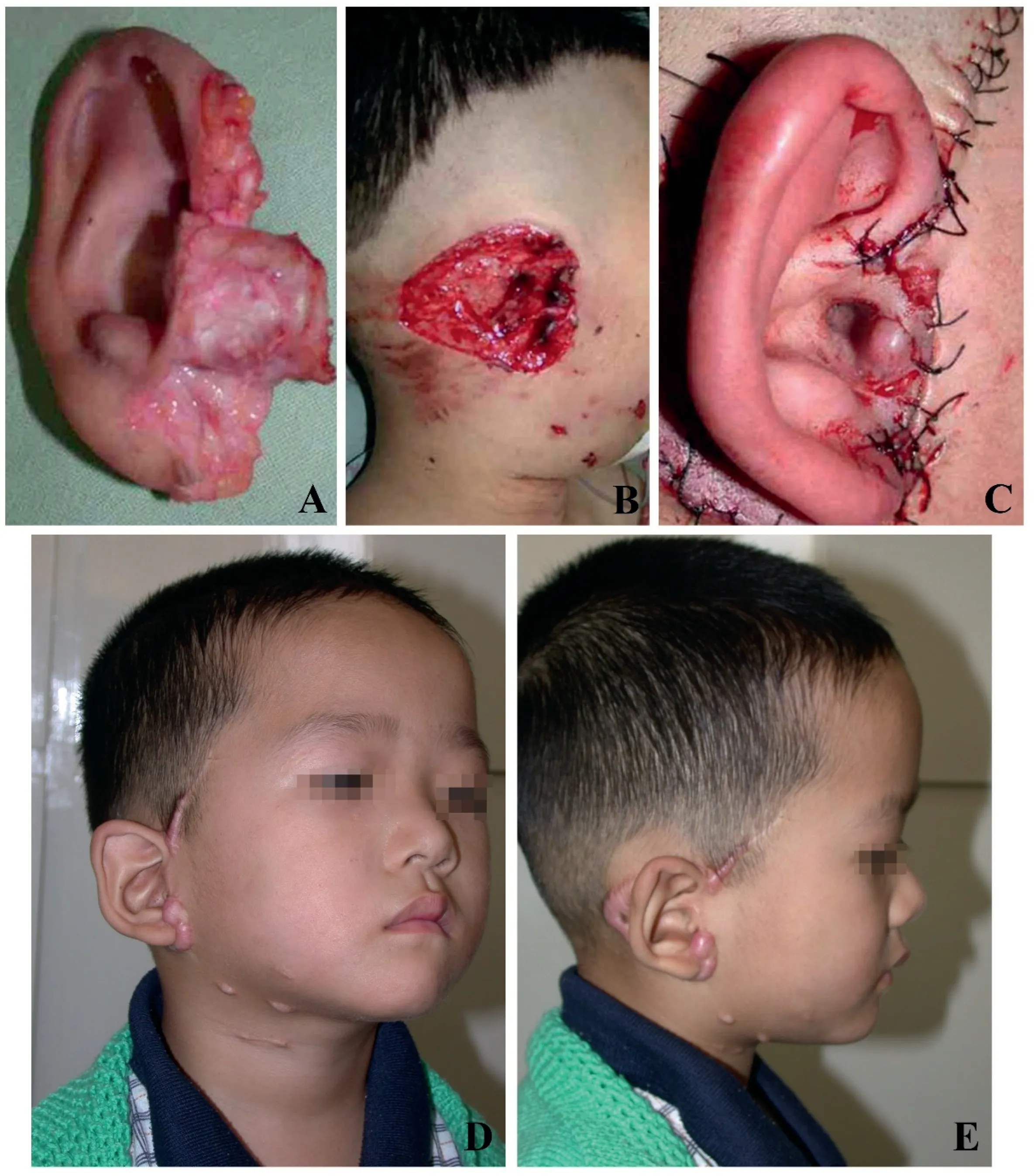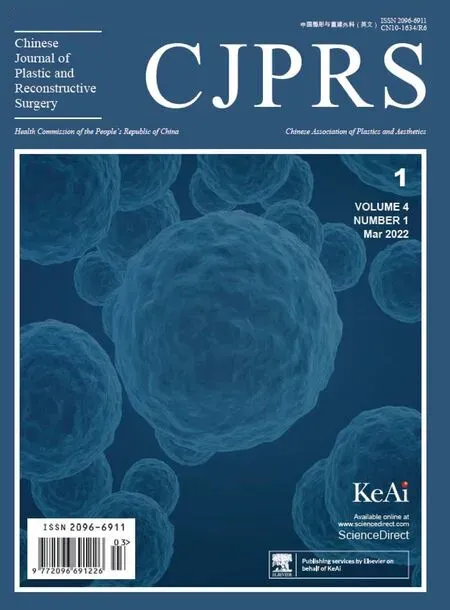Using the parietal branch of superficial temporal vessels:A good approach to total ear replantation
Ying Liu ,Yi Zhang ,Jiao Wei,Tingliang Wang,Jiasheng Dong,Chuanchang Dai ,Hua Xu
Department of Plastic and Reconstructive Surgery,Shanghai Ninth People’s Hospital,Shanghai Jiao Tong University School of Medicine,Shanghai 200011,China
Keywords:Microsurgical replantation Ear amputation Superficial temporal vessels
ABSTRACT Although ear reconstruction is a mature procedure,emergency microsurgical replantation has still been regarded as the optimal treatment for ear amputation due to its cost-effectiveness and aesthetically pleasing results.Successful microsurgical ear replantation is rare because of the difficulty in identifying suitable vessels for anastomosis.We describe two cases of total ear microsurgical replants using the parietal branch of the superficial temporal vessels (STV) as the recipient vessels.The STV parietal branch was dissected up to a sufficient length after thorough debridement,and the amputated ears were revascularized using end-to-end anastomosis.Our experience shows that the parietal branch of the STV is an ideal recipient vessel option for total ear replantation.
1.Introduction
Ear amputations are common in emergency departments.Primary reattachment is only possible in the case of incomplete amputations.1For complete amputation,tissue fragments smaller than 1 cm3are suitable for composite grafts.2For large pieces of tissue or total ear amputations,microsurgical reattachment is the best treatment option,with good cosmetic and functional results;however,identifying the right vessel for anastomosis can be difficult.Herein,we report two cases of successful microsurgical reattachment of the amputated ears using the parietal branch of the superficial temporal artery.
2.Case presentation
2.1.Case one
A 4-year-old boy suffered a dog bite avulsion of the entire right ear associated with a 2-cm external canal and partial retro-auricular skin(Fig.1A and 1B).He presented to our emergency room approximately 5 hours after the injury,with the amputated part well cryopreserved.Operative exploration of the amputated part identified the stumps of the posterior auricular artery and vein with a luminal diameter measuring around 0.3 mm in the earlobe region.After adequate debridement,the superficial temporal vessel (STV;scalp vessels) as a pedicled vascular leash was elevated and then brought to the postauricular area from the anterior auricle.The parietal branch of the STV was anastomosed to a branch of the posterior auricular artery and a vein(0.3 mm in diameter)in the earlobe using an operative microscope and 11-0 nylon.The ear appeared to be well perfused immediately (Fig.1C).After reperfusion was confirmed,the ear was sutured in the original place with a 5-0 proline suture,and an external canal was anastomosed with a 5-0 absorbable suture.The patient was brought to the intensive care unit 5 hours after the operation.

Fig.1.Case 1.(A)Total ear amputation in a 4-year-old boy.(B)Wound area of the ear stump.(C)Ear appearance immediately after vascular anastomosis.(D,E)Ear appearance at 3 months postoperatively.
Low-dose heparin,intravenous dextran,red sage root injection,and antibiotics were administered for 5 days after the operation.Blood transfusions or leeches were not applied.The replanted auricle did not show postoperative venous congestion and healed completely with 100%survival,resulting in a normal-appearing external ear.The boy was discharged home on postoperative day 10 and remained in a good ear shape after 3 months(Fig.1D and 1E).
2.2.Case two
A 37-year-old man was referred from a district hospital after traumatic amputation of the left pinna(Fig.2A–2C).It was allegedly caused by a human bite during a fight.The entire external ear was amputated from the concha and preserved in cold storage after the fight.
The replantation procedure began 16 hours after the injury.Thorough debridement was performed under general anesthesia.Under microscopic magnification,the potential artery and vein were identified,but the vessels were 0.5 mm or less in diameter.The parietal branch of the STV was dissected to a length that was sufficient with no tension for anastomosis.The vessels of the ear segment were revascularized using end-to-end anastomosis to the branch of the STV with 11-0 nylon.The ear was sutured in place with 6-0 nylon.
After vascular recanalization,the ear appeared to be well perfused immediately (Fig.2D).Low-dose heparin (500 units/h) and antibiotics(cephalosporins,2g/d) were administered for 5 days.The ears were monitored hourly by visual observation.Ten hours after the operation,the ear appeared pale,and the temperature dropped to below normal.Surgical exploration was performed immediately under local anesthesia.The diagnosis of arterial thrombosis was confirmed.After removing the blood clot,the ear was well reperfused.The patient was discharged home on postoperative day 14 and remained in good ear shape after 5 months(Fig.2E and 2F).
3.Discussion
Ear replantation is challenging for reconstructive surgeons.Since Pennington3reported the first successful clinical microvascular ear replantation in 1980,46 articles on the revascularization of amputated ears have been published.In addition,there are other surgical methods for ear reconstruction,such as the Baudet technique4and temporoparietal fascia flap for second-stage ear reconstruction.5,6In some cases,the amputated ear was reattached to the stump and could still live without microrevascularization as it relies on tissue fluid exudation for nutrition.7Some doctors used continuous local hyperbaric oxygen,platelet-rich plasma,and polydeoxyribonucleotide to strengthen the blood supply of the amputated ear.8Although several techniques exist,ear replantation with vascular anastomosis has the best results.It is now widely accepted that microsurgical replantation delivers the best aesthetic outcomes and should be attempted whenever possible.Juri et al.9reported the use of the STV for ear replantation in 1987.
From our observations,using the parietal branch of the STV is a better option for total ear replantation than primary repair in the cases mentioned above.The vessels can be dissected to the required length without tension,which can avoid using the bridge vessels,thus shortening the time for operation and reducing the risk of anastomotic thrombosis.If the condition of the stump is not good,the avulsed ear can be sutured directly to the scalp after vessel recanalization and then implanted backin situto reduce the risk of infection.Nevertheless,the disadvantage of this technique is that it seems to eliminate the future use of the ipsilateral temporal superficial fascia as a pedicle flap based on the STV.
High-quality venous anastomosis is needed,and special aspects should be observed.Because appropriately sized veins are often not identified after thorough debridement,arterial anastomosis should be performed first.The vein is located according to the bleeding spots.Because the vein wall is too thin and fragile to be clipped,the nearby ear tissue should be clamped instead of the venous wall.When suturing,heparin mixed with saline should be used continuously to allow the vein to float in the solution to reveal the lumen fully.Nevertheless,microsurgical ear replantation often requires a lengthy operation with a high failure rate.10,11
The failures of ear replantation from human or animal bite cases reported in the literature were mostly due to venous congestion and infection.After bites,bacteria and various digestive enzymes in the mouth increased the risk of wound infection,leading to vascular embolism.Leeches were often used as a salvage method for ear replantation in cases that were short of venous outflow in the presence of valid arterial inflow,12yet the use of leeches in embolism cases was not available in our situation.
4.Conclusion
In this report,two successful cases of severe ear replantation were described.Surgeons should choose an appropriate surgical procedure suited to the unique nature of each patient’s auricle injury.The use of the parietal branch of the STV can be a better choice for total ear replantation.A successful surgery alleviates the patients’ physical and psychological pain and achieves satisfactory aesthetic results.
Ethics approval and consent to participate
The need for ethical approval and consent to participate was waived due to the retrospective nature of this study.
Consent for publication
All the patients gave written informed consent to publish the data contained within this study.
Competing interests
The authors declare that they have no competing interests.
Authors’contributions
Liu Y:Writing-Original draft.Zhang Y:Writing-Review and Editing.Wei J:Investigation.Wang T:Investigation.Dong J:Supervision.Dai C:Conceptualization.Xu H:Conceptualization.
 Chinese Journal of Plastic and Reconstructive Surgery2022年1期
Chinese Journal of Plastic and Reconstructive Surgery2022年1期
- Chinese Journal of Plastic and Reconstructive Surgery的其它文章
- Clinical applications of paraumbilical perforator flaps in multiple angiosomes for the reconstruction of the upper limbs
- Foreword from Dr.Chin-Ho Wong
- Effect of local massage on prevention and treatment of intra-arterial polymethyl methacrylate embolism complications:An experimental animal study
- Applying the Passot technique in the surgical treatment of severe gynecomastia:A case report and literature review
- External application of a Nocardia rubra cell wall skeleton in the treatment of diabetic foot ulcers
- Polyacrylamide gel migration after injection for breast augmentation:A case report
